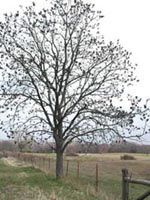Resource Library
Plant of the Week: Kentucky Coffee Tree
The University of Arkansas System Division of Agriculture does not promote, support or recommend plants featured in "Plant of the Week." Please consult your local Extension office for plants suitable for your region.
Plant of the Week
Kentucky Coffee Tree
Latin: Gymnocladus dioicus

It’s always difficult to determine exactly when something begins, but I trace my interest in plants back to a childhood event in a tractor-tire sandbox. In with the trucks and sand was a cargo of tree seeds I had gathered on a recent foray to the creek. The black, marble-size seeds were those of the Kentucky coffee tree, Gymnocladus dioicus. I was fascinated when a few began to sprout.
The Kentucky coffee tree is native west of the Allegheny Mountains where it grows in widely scattered stands in the drainage of the Ohio, northern Mississippi and rivers to the west of the Big Muddy until the prairies begin. It’s found throughout Arkansas, but nowhere is it as common as a native tree. This tree is one of the 50 or so native North American plants that has a single, closely related species in China that was set adrift when the continents separated eons ago.
Kentucky coffee trees can reach 100 feet in deep, bottomland soil, but on upland sites it’s usually half as tall. It’s a sparsely branched, round-headed tree with little patience for twiggy growth. In fact the Latin name translates as " naked branch," a reference to this absence of twigs. The bark is gray and peels in thin, upturned segments producing a subtly attractive display.
The leaves are doubly compound to 30 inches in length and 20 across. The individual, two-inch long leaflets are borne on a stout rachis and are gray-green in the summer and turn yellow in the fall before dropping.
The white flowers are produced in erect panicles, but they are seldom noticed on the Kentucky coffee tree, largely because they’re produced in late spring after the leaves appear, and they’re far from the ground on the ends of the upturned branches. Because it’s a member of the legume family, the pods are about the same shape as a lima bean. But instead of being thin and succulent, these are 10-inch long, black, leathery affairs that hang on the tree all winter long like so many dangling fruit bats.
Inside the pods are the afore mentioned black seeds. It’s from these that the tree received its common name. I find no first-hand account of the culinary attributes of drink made from roasted and ground Kentucky coffee tree seeds, which leads me to believe the practice was one of desperation, not preference.
The Kentucky coffee tree is not commonly offered in the nursery trade because the taproot makes the tree somewhat difficult to transplant and its relatively slow growth rate makes it somewhat unprofitable for growers.
But for landscape trees, a modest growth rate is often a plus because the tree is less likely to overpower its neighbors. The tree, especially a male selection, is an ideal lawn tree because its sparse branching habit allows enough light to pass through its branches to permit grass to grow.
Growing Kentucky coffee tree from seed is easy. Their only dormancy is one imposed by a hard seed coat, so filing down seeds with a hand file or rubbing them across a piece of sandpaper will permit water to enter and produce rapid germination. The trees can be grown in a one-gallon nursery container or planted in your vegetable garden for transplanting after the first growing season.
By: Gerald Klingaman, retired
Extension Horticulturist - Ornamentals
Extension News - February 14, 2003
The University of Arkansas System Division of Agriculture does not maintain lists of retail outlets where these plants can be purchased. Please check your local nursery or other retail outlets to ask about the availability of these plants for your growing area.